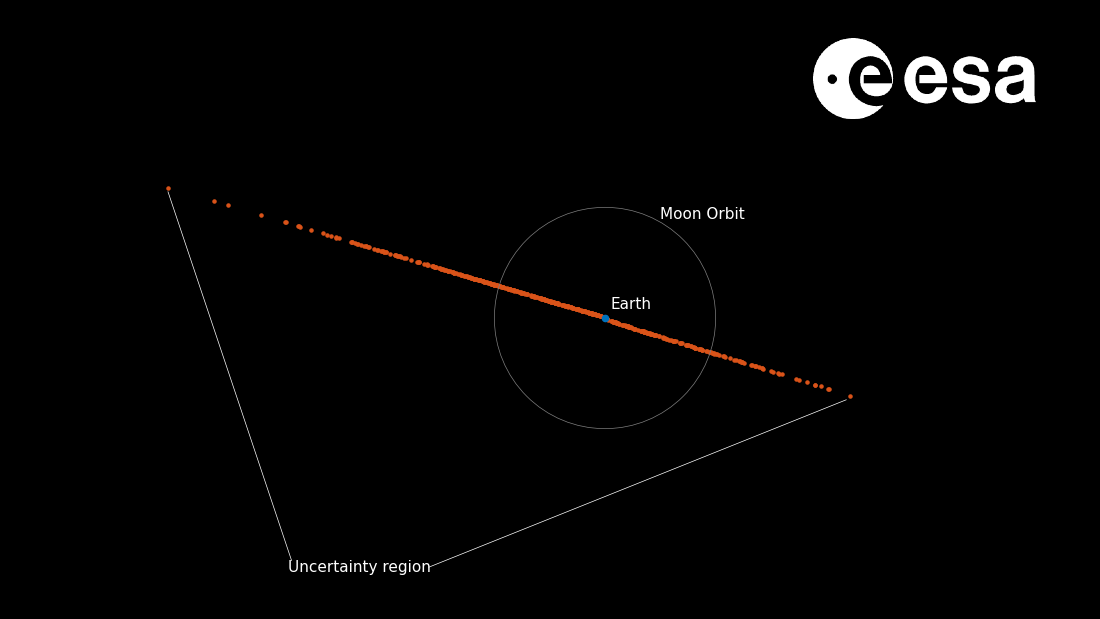The experts in ESA’s Planetary Defence Office have determined that, as of 6 February, the risk of 2024 YR4 impacting Earth on 22 December 2032 is 1.8% — a small increase from the 1.2% estimate published in the ESA website on 29 January due to new observational data. This numerical value is expected to evolve in the coming weeks as additional observations are reported, first rising and then falling, if this asteroid follows the pattern of past such discoveries.
Basically, the more observations we get, the more we can localise and confirm the asteroid’s trajectory, which is most likely to turn out to be a flyby, and not an impact. Hence, we expect the risk forecast can be steadily/stepwise reduced to zero.
One factor specific to this asteroid, it should be noted, is that it is presently moving away from Earth on a curved, receding orbital path. So, observers are going to require larger telescopes every time, which is what’s needed to refine our knowledge of the trajectory.
Also, the exact size of the object remains unknown, with the current estimate running at 40–90 m diameter. As such, this asteroid will steadily recede and soon (within the next few weeks) become too faint for medium telescopes to detect.
By the end of February, it will become too faint for even professional, 4 m-class telescopes to see, and within April, astronomers would need ‘big iron’-class optics to continue tracking, namely James Webb Space Telescope from space or the European Southern Observatory’s Very Large Telescope (VLT), with 8 m-class optics – some of the world’s best. But it is guaranteed to disappear from humankind’s view by May, and will not reappear again until June 2028.
What all this means is that we may not get sufficient observational data before it’s gone to fully reduce the risk to zero and rule out an impact in 2032.
But when ESA or anyone talks about risk as a ‘percentage’, the question is: percentage of what?
To understand this, take a look at the graphic below.

This graphic was prepared by the team at the Near-Earth Object Coordination Centre at ESA’s ESRIN establishment near Rome. It shows a simple, global view looking ‘down’ on Earth and the Moon, onto the plane of the Ecliptic (the Ecliptic can be thought of as the ‘equator’ of our Solar System) and the possible asteroid positions close to our planet on 22 December 2032.
The red line is a time propagation comprising 500 points at which the asteroid might pass by Earth, to the left or the right (or intersecting Earth), generated by a Monte Carlo simulation. Basically, this is like tossing the dice 500 times to see, randomly, where the asteroid might head, looking ‘into’ the plane of the graphic.
The line ends up running about 160x wider than the diameter of the Earth itself, so it is roughly 2 million km long. Our planet is about 12 756 km wide, and so our risk assessment is simply the ratio of Earth’s width to the width of the generated line, which comes out to about 1.8%.
Note that there are more of the red dots nearer Earth, indicating that the distribution is not purely uniform along the entire length of the line (it’s actually closer to gaussian), and so the risk is actually higher where the red dots are denser, closer to Earth.
But, essentially, and when we still have not-yet sufficiently precise orbital data, the risk can be taken as the ratio of the width of Earth to the width of the line. This will surely become clearer in future.

Discussion: 8 comments
What about the moon?
If the asteroid is likely to hit the earth, we would likely attempt a mission to deflect or divert it.
But would we do the same for the moon? Another crater would be no sweat — but is this asteroid large enough to affect the moon’s orbit in any meaningful way?
I would say it’s more dangerous 2024 Yr4 impacting the moon than the earth. Moon has not atm. and its mass is les tnan 1.5% Earth mass.
Hi from Spain
I’m physicist
Do you mean because all the debris potentially ejected from the impact would (most of it) fall on Earth in a distributed way causing a bigger disruption?
Many years ago I watched a very interesting documentary about the impact 65m years ago saying that it was more that, after the impact in the Gulf of Mexico (yes, of Mexico), most of the metallic material in the asteroid, molten and split in smaller pieces, bounced back out of the atmosphere and fell down all over the planet causing wild fires everywhere over months if not years. That was more the cause for extinction than a huge but local impact.
The proof for that theory is the generalized high content of titanium (I think, if not, it was some other metal) in the geological layers of that time found all over the planet.
iridium
Our ability to predict where an asteroid is going will never not be cool haha.
I wonder if the Casino branch sponsors the use ofthis sort of calculation….
It seems weird to say “1,8%” when the intensity of the red dots is much closer to Earth than the ones far away.
With better calculations, the edges will get closer to Earth (hence the higher risk result in calculations over time), and once we’re much further, we’ll be able to move the edges of the passing trajectory simulations to be both on one side of Earth, and then it finally drops to 0.
Looking forward to find out Earth is safe again, except from our own stupidity.
What is the direction of propagation on this plot?
And 2024 YR4 also crosses orbits of other asteroids in the period up to 2032 with which it may even collide ? This has also been studied for the asteroid Apophis.